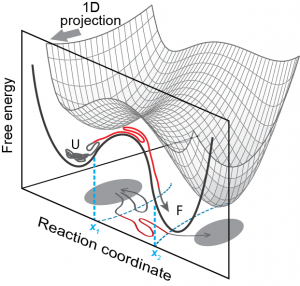Transition paths and the physics of folding reactions
Biological molecules like proteins, DNA, and RNA spontaneously self-assemble into from linear polymers into complex three-dimensional structures capable of carrying out specific physiological tasks. This “folding” process is described physically as a diffusive search over a multi-dimensional landscape representing the free energy of the molecule as a function of all possible conformations. In this picture, the most important parts of folding reactions involve passage through the transition states located in the energy barrier separating the folded and unfolded states: the transition states dominate the reaction kinetics, and the paths through these states—known as transition paths—encapsulate all the critical mechanistic information. Because transition paths are stochastic but the folding of ensembles of molecules cannot be synchronized, single-molecule approaches are needed to observe them. Furthermore, because the duration of transition paths is very short compared to the lifetimes of folded and unfolded states, both high resolution and high dynamic range are required.

We use optical tweezers to induce folding and unfolding transitions in single molecules and directly observe the transition paths. We aim to probe the mechanisms of the folding reactions for different types of molecules, and also to characterise the physical parameters that determine the microscopic dynamics within the transition paths, such as the landscape roughness and internal friction. Interpreting these measurements typically requires that we also reconstruct the profile of the underlying energy landscape, develop novel statistical methods for analysis, understand how the instrumentation affects the observed behaviour, and relate experimental observations to theoretical expectations. In these studies, we integrate both experimental and theoretical aspects of physics, biology, and chemistry, reflecting the interdisciplinary nature of the research.
We are actively investigating questions such as how transition paths differ for molecules with different folds, how we can we use transition paths to characterise local friction in folding reactions, what are the effects of the multi-dimensionality of folding landscapes, whether we detect the presence of microscopically distinct types of paths across different barriers in the landscape, and how transition paths differ for native folding and misfolding.
